the history of yeovil's pubs
PUBS HOME PAGE |
PUBS INTRODUCTION |
PUBS BY NAME |
BEERHOUSES |
swan inn (2)
Belmont / 59 Park Street / 138 Park Street
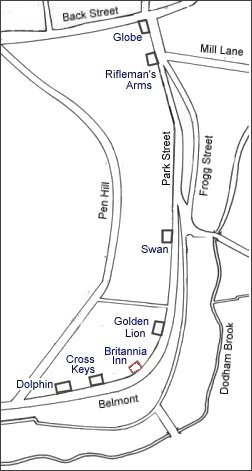 Park Street
was
built between
1825 and 1834 by
Peter Daniell
on the edge of
the grounds of
his
Penn House
estate,
so the Swan Inn dates from
after this time.
Park Street
was
built between
1825 and 1834 by
Peter Daniell
on the edge of
the grounds of
his
Penn House
estate,
so the Swan Inn dates from
after this time.
In fact, the first mention of the Swan Inn I could find was in the 15 March 1830 edition of the Western Flying Post (see Gallery) advertising the sale of the Swan Inn "All those convenient and newly erected Premises, called the Swan Inn, situate in Park Street, in the town of Yeovil, now in the occupation of Mr Samuel Cox; together with the Dwelling-House and Shop adjoining, now occupied by Mr Joseph Hounsell."
It began life as a beerhouse in the wake of the Beerhouse Act 1830. Although it cannot be proved conclusively, judging by the relative position in the census records, this beerhouse was almost certainly the Swan Inn 2. This was Yeovil's second Swan Inn, the first Swan being a 17th / early 18th century alehouse in the Borough.
The building, as seen in the photograph below, was a good two storey, double fronted early Victorian building probably built in rendered brick under a slate roof. It had a nice porch, probably in Ham stone (now removed), supported by a pair of Doric columns with an elaborate wrought iron inn sign bracket above. Fenestration was sash windows to both floors and it appears a bay window was alongside the porch. A porte cochere, or arch, now blocked, led through to stabling at the rear of the property.
The first record I found was the 1839 reference to the Swan in Belmont in Robson’s 1839 Directory. In fact, in view of the 32-year gap in the records it is possible that this may have been a forerunner beerhouse establishment albeit named the Swan. Kelly’s 1895 Directory also lists the White Swan, but this is more likely to be a misprint rather than an accepted name for the inn.
In the early twentieth century the Swan was owned by Brutton's Brewery, later Brutton, Mitchell Toms Ltd. who were taken over by Charrington & Co Ltd, London, in 1960. It was around this time that the Swan ceased trading.
In 1967 Charrington sold the Swan Inn, by this time derelict, to the Yeovil Dramatic Society. For seven years members worked to transform the pub into their headquarters with facilities for rehearsals and set construction although performances still had to take place in hired halls. The society then decided to build its own theatre, the Swan Theatre, on the land behind the building. Its first production there was in 1976.
Many thanks to Rob Baker who sent me the following clipping from the Western Gazette of some twenty years ago which is worth repeating here pretty much in full. As newspapers do, they have got some bits wrong - thanks to Rob for the corrections in blue.
|
"Yeovil's old Park Street may have been one of the roughest areas in town but it was also the best. That was the general consensus of opinion at the Park Street reunion held at the Swan Theatre on Saturday night. Most of the 150 former residents agreed that it was the roughest street in the town but it was full of warm-hearted, kind and community spirited people - the best in Yeovil. Mr Clive White, who was brought up in the street, organised the reunion after reading in the Western Gazette that is was a notorious and rough place. He wanted to prove that "Park Street was full of hard-working people with a great community spirit, the salt of the earth" and he succeeded. Residents told me that although the street had four pubs and two lodging houses there were no muggings, burglaries or child molestings. Policemen may have had to walk down the street in pairs but the residents and their children could walk in safety. The fights that broke out were caused by men visiting the pubs. The street was demolished in stages in the early 1960's as part of a slum clearance programme. Mr White... said "We lived on the fringe of Nine Springs and lived on the edge of town, so we had the country and the town." His brother Terry said although it was the roughest street in town residents could still leave their doors open. The Swan Theatre is the only original Park Street building left. It was one of the four pubs which lined the longest street in Yeovil. One of the two lodging houses was the Cross Keys. It was run by Mrs Florence Essex's grandmother and later by her own father Walter Thorne (this should read Benjamin Thorne). Park Street boys had a reputation for being tough and Mrs Essex's brother Harry was no exception. He set up a boxing ring in the cellar and even used to go a few rounds with the local police chief. Mrs Essex's sister, Mrs Helen Baker (this should read Penelore Baker), lived at the Cross Keys and said they could have 14 men staying in the house and her mother and her sisters would still be safe. ...Mrs Baker said half of Park Street was related and "If you rowed with one, you rowed with the lot." But it was all forgotten the next day... Mrs Clarke said "It was a community in itself. There was no better street than Park Street." She said if you had a baby someone in the street would deliver it and if you died they would lay you out. Mr Arthur Holt... used to play football in the Swan pub's football team over at New Walk which is now the children's play area at Nine Springs. Every Easter Monday the Swan's team used to play against The Golden Lion. Mr Edward Jeans remembered one of the matches, which took place after the pubs turned out. One of the landlords was a goalkeeper and after the match the teams threw the referee in the river because they did not agree with his decisions. "They were nearly all boozed before they even went out" said Mr Jeans. When not playing football the men used to like gambling but as this was illegal they used to hide out in The Copse on the edge of Summerhouse Hill. Mr Charlie Hayter... said when he was a boy he was paid to act as a watch and look out for policemen. Schoolboys also used to enjoy pole-vaulting over the river "But sometimes you did not always make it" he said." |
![]()
I could find no record of Samuel Cox, the first licensee.
Jane Russ was born in Yeovil around 1791. She first appeared in the 1841 census living in Park Street as a 48-year old glove sewer with her two daughters; Mary aged 12 and Jane aged 8. She was listed in Pigot's Directory of 1842 as a retailer of beer but had probably been running a beerhouse before this, possibly since the death of her husband. Indeed she was still licensee in 1850 when listed in Hunt & Co's Directory and was probably running the beerhouse in 1851 when, still in Park Street, she and daughter Jane gave their occupation as glover and Mary as dressmaker. They also had a pauper lodger. By 1861 Mary had married glove cutter Charles White and Jane, simply described as a 73-year old widow, was living with them at Reckleford. In 1871 Jane was one of nine elderly widows living as an annuitant in the Corporation Almshouse on the corner of Union Street and South Street. Jane died in the winter of 1874, aged about 83.
Who'd have thought it? - two men called John Norman, both born in Shepton Mallet, both living in Yeovil in 1881 and both publicans; one at the Railway Inn and the other at the Duke of Wellington in Sherborne Road (there was also a third John Norman who wasn't a publican). Little wonder that, without the benefit of easy internet access to the census returns, eminent Yeovil historians Leslie Brooke and Leonard Hayward confused them. The John Norman who ran the Swan Inn was born about 1822 in Shepton Mallet and is found in the 1841 census living in Shepton Mallet with his first wife, Sarah. John's occupation was given as a hatter. In the 1851 census John was licensee of the Royal Oak in Garston Street, Shepton Mallet and was described as a silk turner and beer house keeper. He and Sarah now had a nine-year old daughter, Henrietta, and a baby son, John. By the time of the 1861 census the family had moved to Yeovil and were living in Wellington Street and John's occupation was now a coal merchant. They were living next door to John's older brother, Daniel, and his family. Daniel was also a coal merchant so it is likely that John moved to Yeovil for the job with his brother. In 1866 John Norman was listed in the Post Office Directory as the licensee of the Swan Inn in Park Street and in January 1870 Sarah died, aged 51. John was recorded there in the 1871 census and was still there in 1875. John remarried in July 1875, his new wife, Ellen, was ten years his junior and was born at Long Sutton. In the 1881 census John and Ellen were at the Railway Inn where John's occupation was given as innkeeper. Living with them and working as a barmaid was John's niece, 25-year old Lucy Manning. John died in October 1883.
The next licensee, James Lucas, was born in Yeovil about 1827. A carpenter and painter, James and his wife, Louisa, had at least seven children. Both James and Louisa were originally from Yeovil but during the late 1840's lived in Peckham and in the early 1860's lived in Clapham, London. In 1871 the family were living in Battersea. By the time of the 1881 census the family had returned to Yeovil and were living in the Swan Inn in Park Street. Although James' occupation was listed as carpenter in the census, he is listed as the licensee in Whitby's Yeovil Almanack Advertiser of 1882. James’ daughter Rebecca was to run the Beehive in Huish for over 30 years.
George Rose was born about 1829 in Sturminster Newton, Dorset, the son of agricultural labourer James Rose and his wife, Dinah of Hinton St Mary, Dorset. By the 1861 census George had married Eleanor and moved to Yeovil where they lived in Waterloo Place, a small yard of housing off Waterloo Lane. The family had moved around a fair bit in the years leading up to living in Yeovil since their children were all born in different towns - Matthias was born in Sturminster Newton in 1856, Samuel was born in Hinton St Mary in 1858 and baby daughter, Anna, was born in Yeovil in 1860. George's 1861 occupation was given as carter. By 1871 the family had moved across the road to Paradise in Huish, named after the colloquial name for the burial ground next to Huish School. There had been three more daughters added to the family and George was now working as a drayman, presumably at Brutton's brewery just around the corner in Clarence Street. Little changed in the following decade other than a move to West Hendford and a few children leaving home. Kelly's Directory of 1890 listed George as the licensee of the Swan Inn however George died in April 1890.
George's son, Samuel, took over the license of the Swan after his father's death and was licensee until at least 1901. (I'm not sure how Oliver Vickery was listed in Whitby's Yeovil Almanack Advertiser of 1898). In the 1901 census he was listed as the publican of the Swan Inn with his wife, Mary, and their three daughters. Samuel died in October 1901 aged just 43.
Harry Leversha was born in 1870 at Stogursey, Somerset, the son of Esau Leversha, a thatcher, and his dressmaker wife, Anne. In the 1871 census Esau, Anne, their three daughters, baby Harry and his older brother were living in Shurton, Stogursey. A decade later, however, Harry and his family were living in the Stogursey Poor House. By 1891 Harry was living in Taunton with his older sister and her family. Both 21-year old Harry and his brother-in-law, Thomas Cross, were bakers. Harry married in 1893 and he and his Yeovil-born wife, Annie Mary, settled in Taunton although I couldn't trace them in the 1901 census, but by 1907 Harry was licensee of the Swan Inn and was listed in the Yeovil Directory of that year. By 1911 Harry was licensee of the New Inn in Middle Street which he ran until at least 1923.
Walter Feltham was born about 1875 in Shaftesbury, Dorset, the son of a hawker, John Feltham, and his wife, Mary. On 25 December 1889 Walter married Sophia Stacey in Shaftesbury. Both were age 19 and Walter's occupation was given as hawker, like his father. Being a hawker, who travelled around selling his wares, is probably the reason that Walter was so elusive in the various census records. Their son, Frank, was born in Cheltenham around 1896 but the next record I found for Walter and Sophia was the 1911 census in which he was described as an innkeeper at the Swan Inn. Walter is finally listed as the Swan's licensee in 1915. Sophia died in December 1925 and in 1927 Walter married Maud Way née Hodges (1894-1934). Walter and Maud had four daughters. At the time they were living in Goldcroft Avenue. Walter died on 9 September 1946 in Yeovil at which time he had been living at 14 Colmer Road.
Following Walter's departure from the Swan, James Lovelace took over the license for a few years and he was followed by Arthur Victor Marsh. Arthur was licensee from the mid-1930's until the mid-1950's.
Sketch Plan of the Swan Inn
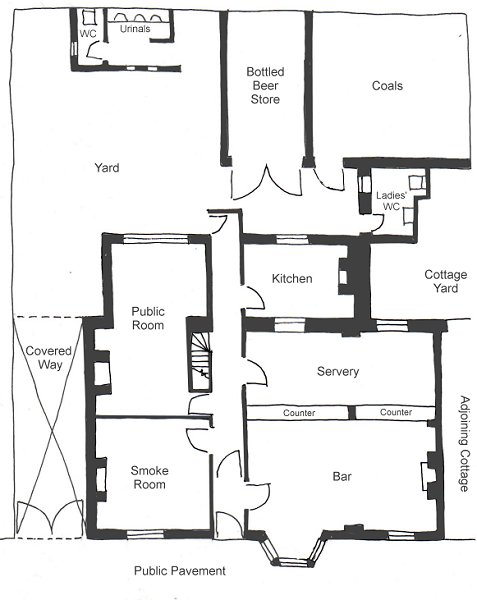
This is a sketch based on plans held at the Heritage Centre, Taunton. The original plans are dated 1948, when Brutton, Mitchell Toms Ltd were the owners. The top half of the public room and the kitchen were single-storey lean-to buildings as were the Gent's and Ladies' toilets, the bottle beer store and the coal store. In 1948 the wall between the smoke room and the public room was removed to make a larger smoke room but half of the earlier public room was partitioned off to form a private living room for the landlord's family. On the first floor were just four bedrooms.
gallery
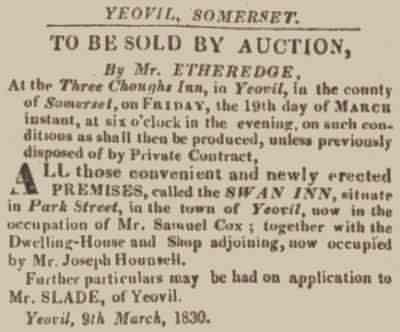
The notice of sale of the Swan Inn in the 15 March 1830 edition of the Western Flying Post.
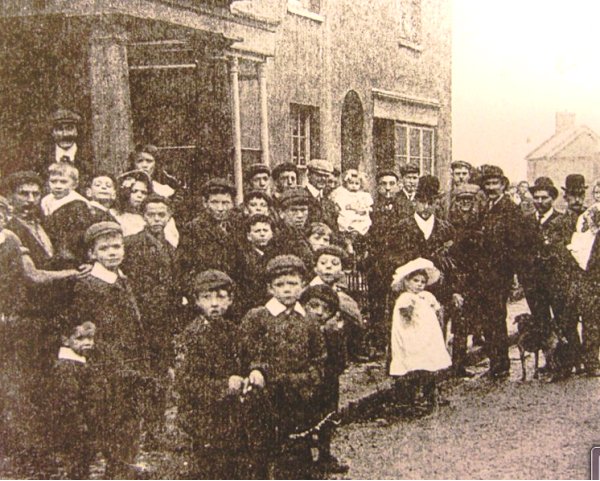
In this grainy, sepia-toned photograph patrons and their families gather outside the Swan Inn around 1905. Is that licensee Harry Leversha standing in the doorway?
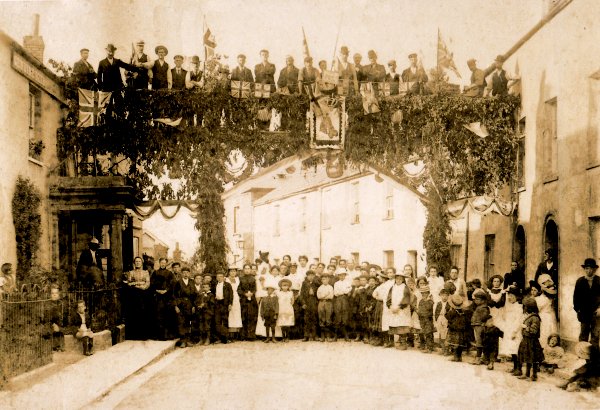
Celebrations at the Swan Inn (at left) - to celebrate the coronation of King George V on 22 June 1911 (instead, it may celebrating the 1902 coronation of Edward VII). At this time Walter Feltham was licensee - with his wife, Sophia, with her arms crossed and by the porch of the Swan.
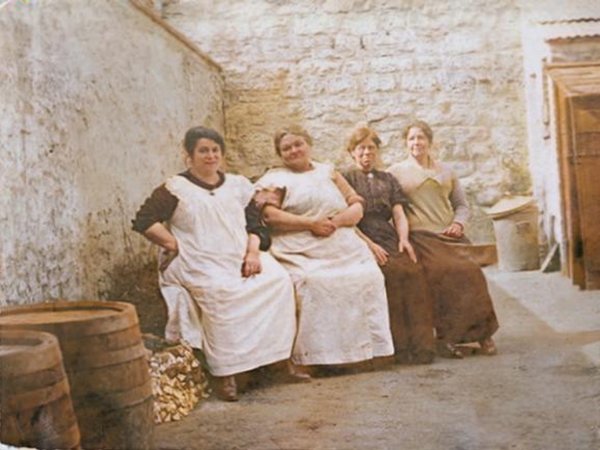
Courtesy of Sue
Boles
A colourised photograph taken in the rear yard of the Swan Inn around 1912, when Walter Feltham was licensee. The ladies, from left to right, are Hettie Gillingham, Ginny Loveless, Eliza Stacey and unknown.
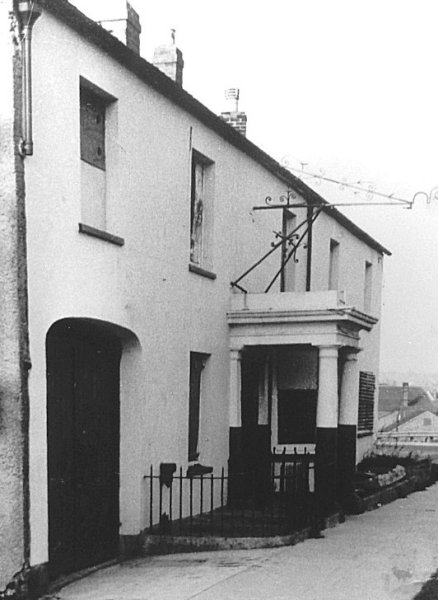
The Swan Inn, circa 1930.
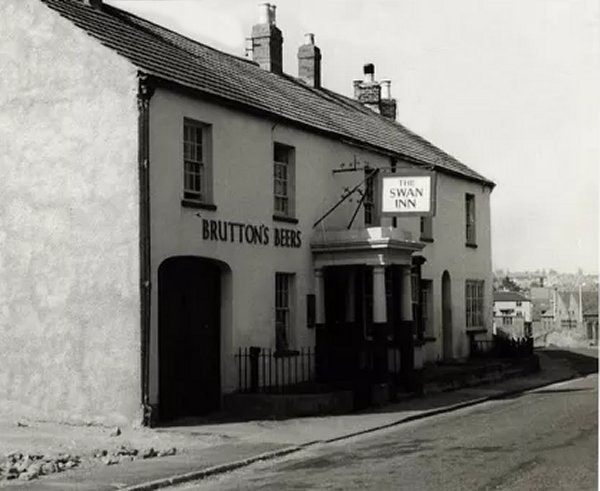
The Swan Inn and the adjoining cottage, photographed in 1960 by Charrington & Co Ltd's surveyors as part of a 'stocktaking' exercise of photographing Brutton's pubs prior to the brewery takeover.
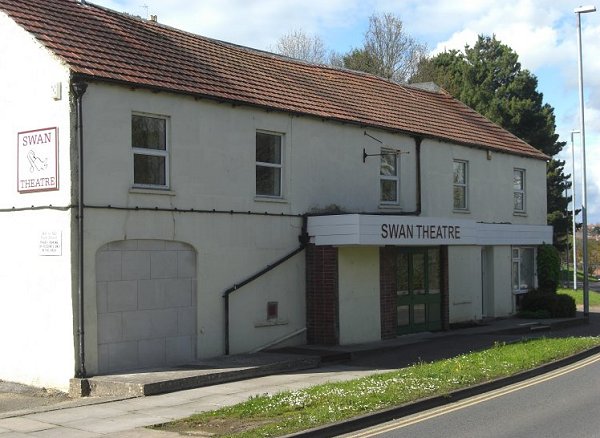
The former Swan Inn, now the Swan Theatre, photographed in 2012. The building is clearly recognisable as that in the photograph above although the archway and window next to it have been blocked but remain discernible. Perhaps the most unfortunate difference is the removal of the fine columned porch.
licensees
1830 – Samuel
Cox (Western
Flying Post)
property sale
1835 – Licensee
not named
(Robson's 1835
Directory)
listed as Swan,
Belmont
1839 – James
Hann (Robson’s
1839 Directory)
listed as Swan
at Belmont
1840 – John Cox
(1840 Somerset
Gazette
Directory)
listed as Swan,
Belmont
1842 – Jane Russ
– Retailer of
Beer (Pigot’s
1842-4
Directory)
1850 – Jane Russ
- Beer Retailer
(Hunt & Co's
1850 Directory)
listed in Park
Street
1859 – David
Marsh (Harrison,
Harrod & Co 1859
Directory)
listed as Swan,
Belmont
1859 – David
Marsh - summoned
for keeping open
after hours (Petty
Sessions)
1866 – John
Norman (1866
Post Office
Directory)
listed as Swan
Inn, Park Street
1871 – John
Norman –
Innkeeper (1871
census) listed
as Swan Inn
1875 – John
Norman – Beer
Retailer ( 1875
Post Office
Directory)
1875 – John
Norman – Beer
Retailer
(Kelly's 1875
Directory)
1881 – James
Lucas -
Carpenter (1881
census) listed
as Swan Inn
1882 – John
Lucas (Whitby's
1882 Yeovil
Almanack
Advertiser)
1882 – John
Lucas (Whitby's
1882 Yeovil
Almanack
Advertiser)
1882 – Swan Inn, Park
Street - fully
licensed inn to
let (Western
Gazette, 8
December)
1890 – George
Rose (Kelly's
1890 Directory)
listed as White
Swan, 59 Park
Street
1891 – Only the
family of Samuel
Rose (presumably
George's son), a
Glover, in
residence
(1891 census)
listed as Swan
Inn
1895 – Samuel
Rose (Kelly’s
1895 Directory)
listed as White
Swan at 138 Park
Street
1898 – Oliver
Vickery (?)
(Whitby's 1898
Yeovil Almanack
Advertiser)
1900 – Samuel
Walter Rose
(Whitby's 1900
Yeovil Almanack
Advertiser)
listed as Swan
Inn,
138 Park
Street
1901 – Samuel
Rose – Publican
(1901 census)
listed as Swan
Inn at 138 Park
Street
1902 – Samuel
Rose (Kelly’s
1902 Directory)
listed as Swan
Inn although
Samuel had died
in October
1901.
1907 – H
Leversha (1907
Yeovil
Directory)
1911 – Walter
Feltham – Inn
Keeper (1911
census) listed
as Swan Inn, 138
Park Street
1914 – Walter
Feltham (Kelly’s
1914 Directory)
listed as Swan
PH
1915 – W Feltham
(Whitby's 1915
Yeovil Almanack
Advertiser)
1919 – James
Lovelace
(Kelly’s 1919
Directory)
listed as Swan
PH
1923 – James
Lovelace
(Kelly’s 1923
Directory)
listed as Swan
PH at 138 Park
Street
1936 – AV Marsh
(1936 Yeovil
Directory)
listed as Swan
1935 – Victor
Marsh (Kelly's
1935 Directory)
1938 – AV Marsh
(1938 Yeovil
Directory)
listed as Swan
1939 – Arthur
Marsh (Kelly’s
1939 Directory)
listed as Swan
PH
1947 – AV Marsh
(1947 Yeovil
Directory)
listed as Swan
1949 – AV Marsh
(Kelly’s 1949
Directory)
listed as Swan
1951 – AV Marsh
(1951 Yeovil
Directory)
listed as Swan
1954 – AV Marsh
(1954 Yeovil
Directory)
listed as Swan
1957 – W
Hutchings (1957
Yeovil
Directory)
listed as Swan
Inn
1960 – Licensee
not named (1960
Yeovil
Directory)
listed as Swan
Inn
1965 – Licensee
not named (1965
Yeovil
Directory)
listed as Swan
Inn